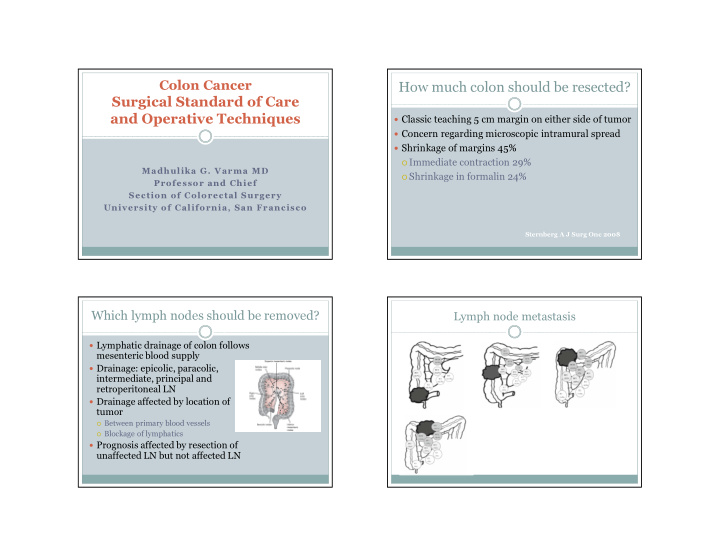



Colon Cancer How much colon should be resected? Surgical Standard of Care and Operative Techniques � Classic teaching 5 cm margin on either side of tumor � Concern regarding microscopic intramural spread � Shrinkage of margins 45% � Immediate contraction 29% Madhulika G. Varma MD � Shrinkage in formalin 24% Professor and Chief Section of Colorectal Surgery University of California, San Francisco Sternberg A J Surg Onc 2008 Which lymph nodes should be removed? Lymph node metastasis � Lymphatic drainage of colon follows mesenteric blood supply � Drainage: epicolic, paracolic, intermediate, principal and retroperitoneal LN � Drainage affected by location of tumor � Between primary blood vessels � Blockage of lymphatics � Prognosis affected by resection of unaffected LN but not affected LN Park IJ et al Ann Surg Onc 2009
How many lymph nodes should be removed? Does LN harvest affect stage and prognosis? � #LN retrieved is considered a quality measure � 1996-1997 15% hospitals compliant with 12 LN retrieval measure � 2004-2005 compliance only 38% � Most compliant were NCI designated cancer centers(78%) compared to academic (52%),VA (53%) or community(33%) � Many patient-level studies suggest that retrieval of 12 LN SEER Database 1998-2008 confers survival advantage 86,3094 patients with colon cancer � However, use of national database for a hospital –level Evaluate LN number with positivity and hazard of death study suggests that hospitals with higher LN retrieval rates after colectomy for colon cancer do not have better survival rates Parsons JAMA 2011 What about radial margins? Systematic Review of colorectal resection margins and lymph nodes 107 articles Majority of poor quality West NP et al Lancet Oncol 2008
What about laparoscopic resections? � Localization critical � Colonoscopy for cecum with landmarks or verification by CT � Tattoo at time of colonoscopy or even repeat procedure to tattoo may be indicated � Distant disease � Can assess peritoneal and liver surfaces � Cannot palpate for deeper parenchymal tumors � Always need preoperative CT Scan � Laparoscopic ultrasound/guided biopsy Published Trials Does laparoscopy affect resections? � NIH sponsored COST trial � Prospective Randomized Controlled Trial COST TRIAL 2004 Laparoscopic Open � Multicenter- 48 institutions Bowel Length (cm) 26 27 � 872 patients � Early follow up reported (NEJM 2004) Proximal Margin (cm) 12 11 � 5 yr follow up reported (Ann Surg 2007) � Planned follow-up 8 years Distal Margin (cm) 10 12 � Six other international trials Mesenteric length (cm) 9 8 � COLOR (RCT) � LCSSG (Prospective cohort) # of Lymph Nodes 12 13 � CLASSICC P=NS
COST Trial Cumulative Recurrence Rate Wound /Port Site Recurrences Author Yr N Incidence (%) Berends 94 14 21.0 Drouard 95 507 2 .4 Boulez 96 117 2 .5 Franklin 96 191 0 Melotti 99 163 1.2 Schiedeck 00 399 0.2 Lujan 02 102 2 Lacy 02 111 0.9 COST 04 408 0.5 3 yr Follow Up 5 yr Follow Up CLASSICC 07 526 2.5 Nelson NEJM 2004 Fleshman Ann Surg 2007 COLOR Trial COST Trial Overall Survival 540 pts each arm 3 yr Follow Up 5 yr Follow Up Overall Survival Bonjer et al. Lancet 2009 Nelson NEJM 2004 Fleshman Ann Surg 2007
CLASSICC Trial CLASSICC Trial Overall Survival Jayne et al J Clin Oncol 2007 Colon Cancer Open 67% vs Lap 68% Meta-analysis of RCTs All Included Studies Jackson et al J Am Coll Surg 2007
No Difference in LN retrieval No Difference in Recurrence Rate Meta-analysis of Largest RCTs No difference in Cancer-related Death � Databases of Barcelona, COST, COLOR and CLASICC � All patients at least 3 years of FU � 44 institutions in North America � 48 institutions in Europe � Primary outcome: overall and disease free survival Bonjer et al Arch Surg 2007
Survival Lap Open OS 82% 84% DFS 76% 75% Assessment of LN harvest and resection � COST trial analyzed the effect of #LN, length of resection, mesenteric length and survival in setting of many surgeons who were credentialed and video audited for adherence to technical standards � No difference in survival based on LN retrieval or other anatomic factors � There was variability in the surgeons in terms of case volume but no effect on overall survival � Technical credendtialing can help to standardize oncologic resection regardless of case volume Mathis et al Ann Surg 2013
COST Disease Free Survival by Stage Quality of Life Measures Stage 1 Combined � Part of NIH trial � 449 patients with colon cancer � Inclusion criteria � Adenocarcinoma of only a single colon segment � >18 yo � Exclusion criteria � Transverse colon or rectal cancer Stage 2 � Obstructed/perforated colon cancer Stage 3 � Metastatic disease � Scars/adhesions that would prevent laparoscopic surgery � Concurrent or previous malignant tumor � ASA physical status classification of IV or V � Unable to speak English, cognitive impairment, no telephone (for QOL) Quality of Life Measures Symptom Distress Score � Scores on the Symptoms Distress Scale (SDS) � 13-item scale � Nausea, appetite, insomnia, pain, fatigue, bowel, concentration, appearance, breathing, outlook, and cough � Quality of Life Index � 5-item scale � Activity, daily living, health, support, and outlook � Single-item Global Rating Scale � “On a scale of 0-100, with 0 being death, and 100 being excellent health, which number would you say best No significant difference in distress scores at 2 days, weeks or months describes your state of health over the past 2 weeks?” Single-Item Global Rating Scale Mean scale at two weeks for Lap vs Open: 76.9 vs 74.4 (P=0.009) All other parameters were equivalent
Summary � Surgery for colon cancer has advanced technologically but oncologic principles are paramount to achieving good outcomes � More attention is being paid to the specimen as opposed to how it was removed � Difficulties with laparoscopy for colon surgery have diminished with new equipment and experience � Newer technologies such as Robotics, single site laparoscopy and NOTES continue to be tested but have not yet achieved widespread use
Recommend
More recommend